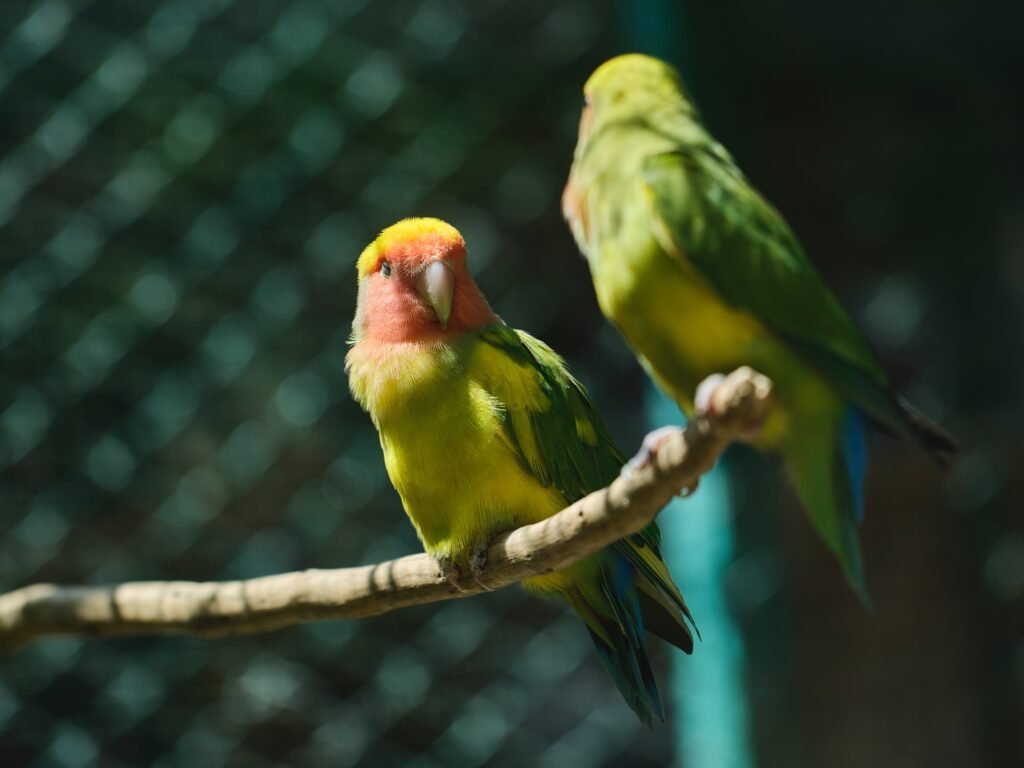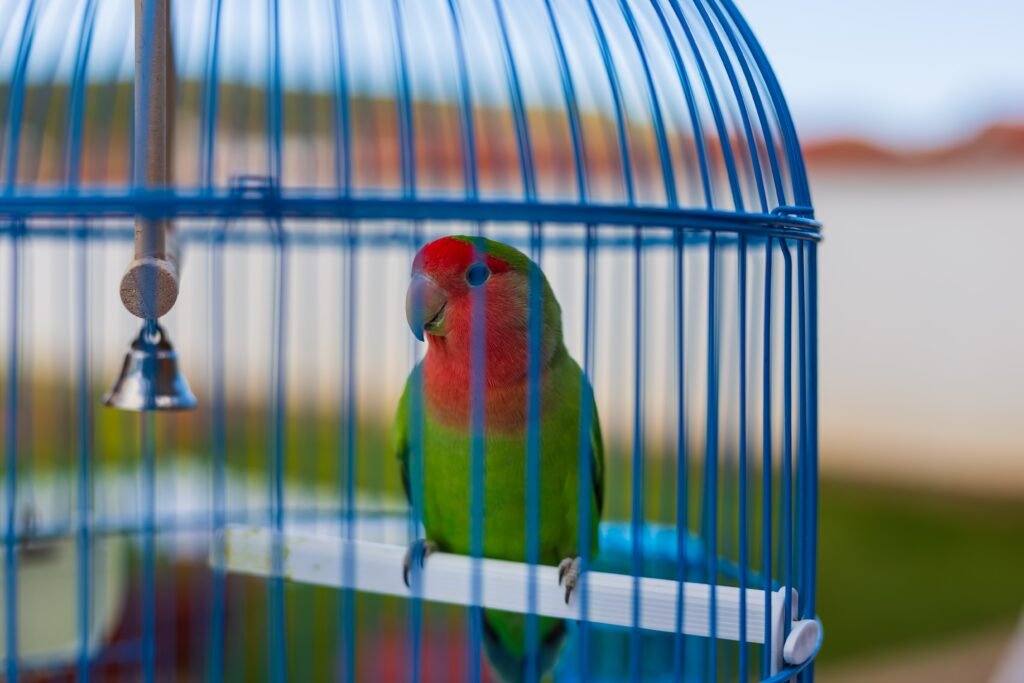Lovebirds are renowned for their beautiful plumage, captivating personalities, and extraordinary courtship rituals. These small, colourful parrots have captured the hearts of bird enthusiasts worldwide, and their mating behaviour is a fascinating aspect of their lives. This article will delve into the intricate world of lovebird courtship, exploring their unique behaviours, rituals, and the importance of proper care and understanding during this crucial time.
Understanding Lovebird Mating Behavior
Lovebirds are monogamous birds, meaning they form long-term mating pairs. Once a bond is established, these pairs remain faithful to each other throughout their lives. This commitment is truly remarkable and adds to their endearing charm.
Bonding and Mate Selection
Lovebirds go through a bonding period to initiate the courtship process. During this time, they engage in various behaviours to establish a strong connection. These behaviours include preening to each other, sharing food, and engaging in mutual grooming. Preening is a vital bonding activity for lovebirds as it helps maintain their feathers and strengthens the emotional bond between them. By sharing food, lovebirds demonstrate their trust and affection for one another. Mutual grooming plays an essential role in courtship, as it helps to establish a sense of intimacy and reinforces their bond.
Once the bond is established, lovebirds choose their mates carefully. They often display courtship behaviours to communicate their interest and compatibility. These behaviours include singing, dancing, and displaying their vibrant plumage to attract potential partners. Lovebird courtship dances can be quite intricate and involve a variety of movements, such as hopping, wing flapping, and head bobbing. These captivating displays not only serve to attract a mate but also showcase their fitness and genetic quality.
Nest Building
Lovebirds prepare for mating by building nests. They are incredibly resourceful and use various materials, including twigs, leaves, feathers, and droppings, to construct their nests. The nest provides a safe and secure environment for the pair to raise offspring. Lovebirds meticulously build their nests, ensuring they are structurally sound and well-insulated. Using a combination of materials, they create a cozy and comfortable space for their future family.
Mating Rituals
When a lovebird pair is ready to mate, they engage in a series of rituals that strengthen their bond and prepare them for reproduction. These rituals often involve intricate behaviours such as beak rubbing, wing fluttering, and regurgitating food to feed each other. Beak rubbing is a form of affectionate behaviour that lovebirds use to reinforce their bond. It is a gentle and intimate gesture that signifies their emotional connection. Wing fluttering is another courtship behaviour that lovebirds engage in. This behaviour involves the male lovebird rapidly fluttering his wings to impress the female. It is a visually striking display that showcases the male’s strength and vitality. Regurgitating food is crucial to lovebird courtship, representing nurturing and caring for one another. By regurgitating food, lovebirds communicate their willingness to provide for their mate and potential offspring.
The Act of Mating
Lovebirds engage in a unique mating ritual. The male lovebird mounts the female from behind, grasping her with his beak and feet. This position is known as a cloacal kiss, during which the cloacae of both birds come into contact, allowing for the transfer of sperm. This process, though brief, is essential for successful fertilization. After mating, lovebirds may engage in a period of mutual preening and cuddling, further solidifying their bond.
Lovebird Courtship: Care and Considerations
Proper care and understanding during the courtship period are vital for the well-being of lovebirds. Here are some important considerations:
Diet and Nutrition
A balanced diet is crucial for lovebirds, especially during the courtship period. Providing a variety of fresh fruits, vegetables, seeds, and pellets ensures they receive the necessary nutrients for reproductive health. Lovebirds require a high-quality seed mix that includes a variety of seeds, such as millet, sunflower, and safflower. Additionally, offering fresh fruits and vegetables, such as apples, carrots, and leafy greens, provides essential vitamins and minerals. Calcium-rich foods, such as leafy greens and cuttlebones, are particularly important for egg development. It is essential to ensure that lovebirds can access clean, fresh water.
Environmental Enrichment
Creating a stimulating environment is essential for lovebirds during courtship. Providing toys, perches, and nesting materials allows them to engage in natural behaviours and encourages their bonding process. Toys that can be chewed, swung on, or manipulated help keep lovebirds mentally and physically stimulated. Natural perches of varying sizes and textures promote foot health and provide opportunities for exercise. Offering nesting materials such as coconut fibre, shredded paper, and twigs allows lovebirds to construct their nests. Additionally, providing a secluded area for nest building and mating promotes a sense of security and privacy. Providing a nesting box or a suitable nesting site within the enclosure will help facilitate mating.
Veterinary Care
Regular visits to an avian veterinarian are essential to ensure lovebirds’ overall health and well-being. These professionals can guide nutrition, breeding, and any potential health concerns. It is crucial to monitor the health of both the male and female lovebirds during the courtship period to ensure a successful outcome. The avian veterinarian can perform health checks, offer advice on breeding practices, and provide necessary vaccinations or treatments to prevent diseases. Consulting with a veterinarian experienced in avian medicine will help ensure the best care for lovebirds during this critical time.
Handling and Interactions
During the courtship period, it is important to be cautious when handling lovebirds. They may become territorial and protective, especially around their nests. It is advisable to avoid excessive handling to minimize stress and maintain the bond between the pair. Instead, focus on providing a calm and secure environment for lovebirds to feel safe and comfortable. Observe their behaviours from a distance and allow them to engage in their natural courtship rituals without interference. Gentle and patient interactions, such as talking softly or offering treats, can help build trust with the lovebirds.
Patience and Observation
Understanding lovebird courtship requires patience and observation. Each pair may have its unique behaviours and preferences. By observing their interactions and understanding their needs, you can provide the appropriate care and ensure a harmonious courtship and breeding experience. Pay attention to their body language, vocalizations, and overall behaviour. This will provide valuable insights into their well-being and help you identify any potential issues that may arise during the courtship process. Patience is key during this time, as lovebirds may take varying amounts of time to establish their bond and successfully mate.
In Conclusion
Lovebird courtship is a truly incredible and mesmerizing process. Lovebirds exhibit a remarkable commitment to their partners, from their bonding rituals to their unique mating behaviours. By providing the right care, nutrition, and environment, you can support their mating journey and witness the joy of new life as they raise their adorable offspring. So, embark on this enchanting adventure and explore the fascinating world of lovebird courtship!
Lovebird Courtship FAQ
1. Are lovebirds monogamous?
Yes, lovebirds are monogamous birds. Once a bond is established, they form long-term mating pairs and remain faithful to each other throughout their lives.
2. How do lovebirds choose their mates?
Lovebirds choose their mates carefully. They often display courtship behaviours such as singing, dancing, and displaying their vibrant plumage to attract potential partners. These behaviours serve as a way of communicating their interest and compatibility.
3. What is the importance of nest building in a lovebird courtship?
Nest building is an important part of lovebird courtship. Lovebirds prepare for mating by constructing nests using twigs, leaves, feathers, and droppings. The nest provides a safe and secure environment for the pair to raise offspring.
4. What are some important considerations for lovebirds during the courtship period?
During the courtship period, providing a balanced diet with fresh fruits, vegetables, seeds, and pellets is important to ensure proper nutrition for reproductive health. Creating a stimulating environment with toys, perches, and nesting materials encourages natural behaviours and bonding. Regular veterinary care is crucial to monitor the health of lovebirds and seek guidance on breeding practices. Handling should be cautious to avoid stress, and patience and observation are key to understanding each lovebird pair’s unique behaviours and needs.


